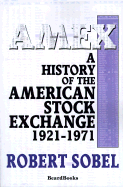|
|
|
|
||||||

|
AMEX: A History of the American Stock Exchange, 1921-1971
By Robert Sobel 2000/03 - Beard Books 1893122484 - Paperback - Reprint - 405 pp. US$34.95 This revealing book, which describes the struggles for leadership and AMEX's return from near-disaster to a position of respect, is a must for anyone who has ever done any stock trading. Publisher Comments AMEX is the fascinating history of the American Stock Exchange, the nation's second largest organized securities complex, from its inception in 1921 to 1971. It begins when the curbstone brokers, AMEX's predecessors, moved indoors and began trading at the New York Curb Market. For the first time, the story is told of the contest among the Big Board, the Curb, and the almost-forgotten Consolidated Stock Exchange. It traces the bull and bear market pitfalls, the political infighting that nearly caused its dissolution, and the reforms that saved the institution. From Henry Berry Robert Sobel is well known to those in the business field. He's written more than fifty books and hundreds of articles on just about every topic in the field. AMEX - A History of the American Stock Exchange, 1921-1971 evidences all the characteristics which have made his writing appealing and informative to business readers -- sound research and expert knowledge put in a colorful, readable style. Writing about individuals and events, Sobel makes business come alive. He begins his history of the AMEX when it was known as the "Curb Market" in the 1800s. The name is not a catch phrase, but is a literal designation of where the activity of this market was conducted -- namely, on a curb on Broad Street under the windows of the established New York Exchange. The origins of the Curb Market, or Curb Exchange as it is called, are traced to the California Gold Rush of 1849. It played an important part in many financial transactions and businesses, particularly mining operations, which rapidly grew out of the Gold Rush. The AMEX was not given its name until 1953. Sobel leads up to this in his early chapters by covering the practices, operations, and representative individuals of the Curb Market which influenced the founding of the AMEX and left their imprint down to today. Unable to compete with the New York Stock Exchange and with no ambition to rival it or replace it anyway, the Curb Exchange traders were enterprising and unconventional. For example, if a trader wanted to become a "specialist" in handling the stock of a particular company, he might buy some of its stock for himself and begin trading it on the Curb Exchange. Most of the stocks handled by the Curb Exchange were from "young companies or marginal firms, many of which would disappear through mergers, bankruptcy, or other means." Some would eventually move to the Big Board. But the precursor to the AMEX also traded in stock of companies such as Standard Oil, U.S. Tobacco, and United States Sugar. Such major corporations, many owned by families, preferred the Curb Exchange because they did not have to file regular reports or financial information as they would with the New York Stock Exchange. The Curb Exchange played an important part in the rampant capitalism of the late 1800s. As the economic and political environment of the country changed into the decades of the 1900s so did it. In 1921, the Exchange moved indoors on Trinity Place in New York City. It had its share of difficulties along with those of the rest of the country in the time of the Depression. But the exchange survived the poor economic times, new government regulations, lackluster leadership, and even a scandal involving two of its most powerful members in the 1930s. Under the strong leadership of Edward McCormick in the 1950s, the Curb was able to put its troubles behind it and finally, after about a century of tentative existence, become established as a major trading institution. With his academic credentials, relationships with members of the SEC, experience in the field of finance, and savvy about the media, McCormick resembled the prominent individuals associated with the New York Stock Exchange. One of the most important steps in McCormick's historic activity was to change the organization's name to the American Stock Exchange on January 5, 1953. Robert Sobel was a professor at Hofstra University for 43 years. From 1972 to 1988 he was a weekly columnist for Newsday. At the time of his death in 1999, at the age of 68, he was a contributing editor to Barron's magazine.
|
|
|
|
home
| about us
| contact us
| related
sites |